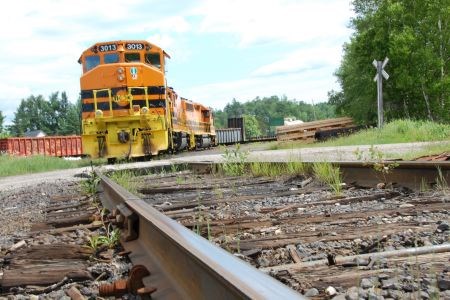Huron Central Railway president Mario Brault was a happy man in August.
Two years after announcing that the rail carrier was dropping freight service in northeastern Ontario, he was talking with blue sky optimism about a profitable month of July with opportunities for building up volume.
“We're open for business now and we'll do everything in our power to take everything that can be moved by rail.”
Politicians and local dignitaries gathered in Sault Ste. Marie, Aug. 10, to mark the official kickoff of reconstruction with a $30-million government investment that will bring much needed upgrades to the short-line railroad.
The federal and provincial governments each contributed $15 million earmarked for track bed improvements with new ballast, crossties, rail replacement and upgrades to bridges.
The Huron Central's American parent company, Genesee & Wyoming, is ponying up $3.3 million.
The money for the four-year reconstruction project preserves 49 railway jobs in Sault Ste. Marie and Sudbury.
The 278-kilometre (173 miles) railroad hauls steel, forest products and chemicals between Sault Ste. Marie and Sudbury. It serves 26 communities and First Nations along the Trans-Canada Highway.
The Sault, Espanola, Essar Steel and Domtar almost lost the Huron Central in 2009 when Genesee & Wyoming declared it was withdrawing service because of declining freight volumes and deteriorating track conditions.
The line is owned by Canadian Pacific Railway (CP), but it is operated by the Huron Central. CP was not prepared to take over service, or invest money, in a line it deemed too marginal to operate.
It forced Sault Ste. Marie and senior government officials to scramble for funds, and for Essar and Domtar to make freight commitments for the line.
In its July traffic statistics, Genesee & Wyoming up from 1,322 carloads during the same period in 2010.
Brault was pleased with the bump in traffic and said the line's profitability should only improve over time.
“July is bang-on for our forecast. It was the first month since the beginning of the year that we were on target. The business is building up quite nicely. We're certainly not up to capacity. We can double and triple this amount.”
Government paperwork and an environmental screening process delayed the start of construction until August.
The spinoffs for this large project are already being felt.
Swift Railroad Contractors received the track upgrading contract which includes replacing 140,000 wood crossties. The Smithville, Ont. company maintains a maintenance shop in Massey.
Supplying the 125,000 tons of new railway ballast will be M'Anishnakbek Industries, a joint venture between Serpent River First Nation and Sudbury's Mansour Group of Companies.
The $30-million operation will utilize a quarry operation based in Cutler that was formerly developed to supply aggregate for the Highway 17 rehabilitation in 2004. Mansour brings to the table decades worth of expertise servicing rail systems for the mining industry.
The Huron Central scored another victory in July by taking over the line's sales and marketing function from Canadian Pacific.
Brault concedes the opportunity to drum up new business is limited since there are few industries along the route.
He acknowledged there may be additional tonnes to be had by acting as a bridge carrier between the Canadian National Railway in the Sault and CP in Sudbury. But those are high level discussions, he said.
“We have a couple of nice opportunities that could develop in the next two to three years, but it's still very early to discuss publicly. We're looking at some bridge traffic and also looking at moving more business from Sault customers like Tenaris Tubes.”
He declined comment when asked if the Huron Central could take advantage of new mine developments in northern Wisconsin and Michigan that could result in ore being moved to Sudbury for processing.
In retrospect, Brault said he's doesn't have a sense whether the small towns serviced by the line have developed a greater appreciation of railways as a valuable piece of transportation infrastructure.
“I think we got a lot of visibility in the major centres like Sault, Sudbury and Espanola. For Domtar, the loss of a railroad would be a total disaster.
“I'm not sure about the smaller communities. I'm getting more traction with some communities that want to establish industrial parks. I think they're starting to realize it's not a bad thing to have a healthy railroad in their backyard.
“But I haven't had a large number of phone calls yet.”
The Huron Central is one of two short-line railway operators in northeastern Ontario.
Last October, Canadian Pacific and Rail America Inc. struck a five-year operating agreement to keep open a threatened 253-kilometre line between Sudbury and Mattawa.




